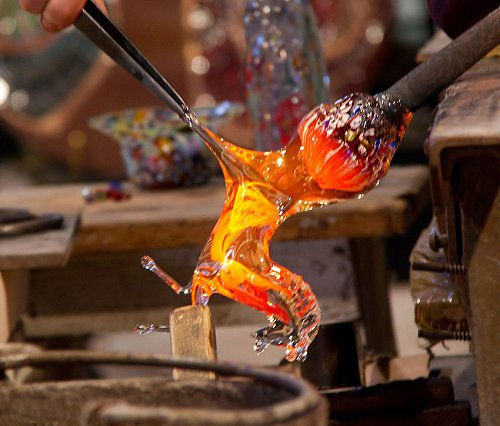Alchemy & Renaissance Glass: Antonio Neri
- Sylvia Rose

- Aug 27, 2024
- 3 min read
Antonio Neri is a Renaissance Florentine priest, well known for contributions to alchemy and glassmaking. As a youth Neri is drawn to the study of alchemical principles and herbology.
Glassmaking, herbology and alchemy are perfect partners.

Alchemy thrives in Greco-Roman Alexandria (c. 30 BCE - 640 AD) because the city is both a glass making center and pioneer in medicine. Alchemists can view their experiments at work in flasks of glass. They use herbal compounds, making alchemy part of the study of herbology.
The purpose is to separate, mix, melt, condense, purify, roast or otherwise process products including plants and plant poisons, for instance henbane or monk's hood. In the quest for the immortality elixir, alchemists expand on medical knowledge.

The flask above is for repeated distillation or cohobation in order to purify the contents and break them down into essential components. Experiments such as these prosper in the medieval convents of Italy, as in medicine.
Physicians can peer into the archetypal stomach of the flask. In alchemy the flask is also the womb, source of creation. In China, the primordial god Shennong teaches humans about herbs. He eats up to 70 poisons a day and sees their reactions in his transparent stomach.
As a container or vessel, glass is resistant to toxic metals such as mercury, which previously is shipped in lead flasks. In medicine and alchemy, and the creation of medical mixtures in herbology, glass is a leap of progress. By the Renaissance it's a commerce.
Born in 1566 Florence, Neri develops a fascination with the natural world and transformative powers. He explores the enigmatic art of alchemy. The height of the Renaissance Golden Age is a cycle of change like that of the Golden Age of Alchemy in Alexandria.

By 1525, Florence is well established as a glassmaking center. Importation of outside glass is forbidden. In 1567, Cosimo de' Medici (1519-1574), the greatest arts patron of his era, negotiates with the Venetian government, to establish a Venetian-style glasshouse in Florence.
Venetian glass (Italian: vetro veneziano) is glassware created in Venice, especially on the nearby island of Murano. It's traditionally made with a soda–lime treatment of dolomite, often elaborate with "hot" glass-forming techniques, as well as gilding, enamel, or engraving.

In the Renaissance, Italy is the center of glass making. Neri works in glassmaking factories of the Medici to learn the trade. He's considered the first to document glass production techniques systematically.
He experiments with different compositions and methods. This leads to the creation of vibrant colors and intricate glass forms highly sought after in Europe. Beyond technical innovations, Neri’s work reflects the broader philosophical currents of his time.

Neri's groundbreaking work culminates in "L'Arte Vetraria" of1612, seen as the first comprehensive treatise on glassmaking. This seminal text documents techniques and recipes for creating various types of glass.
The chapter contents of L'Arte Vetriaria are
Basic glass colours and preparation
Chalcedony glass
Advanced colours
Lead glass and colours
Artificial gemstones
Vitreous enamel
Paints and transparent red glass

He sees the processes of L'Arte Vetraria in creating various types of glass as similar to philosophical concepts and processes of alchemy. He introduces innovative methods for colored glass and glassware.
In L'Arte Vetraria, Neri describes the process of making crocus martis. He explains:
Crocus Martis is nothing other that a refinement and calcination of iron. A means by which its pigment, that in glass is a deep rutty red, is opened and imparted to the glass. It not only manifests itself but makes all the other metallic colors as well, which ordinarily hide and are dead in the glass, dance in resplendent apparition.

Non-Fiction Books:
Fiction Books:
READ: Lora Ley Adventures - Germanic Mythology Fiction Series
READ: Reiker For Hire - Victorian Detective Murder Mysteries



